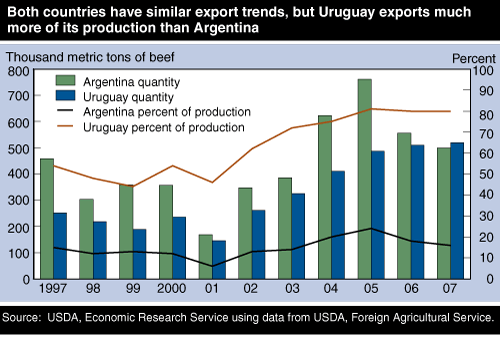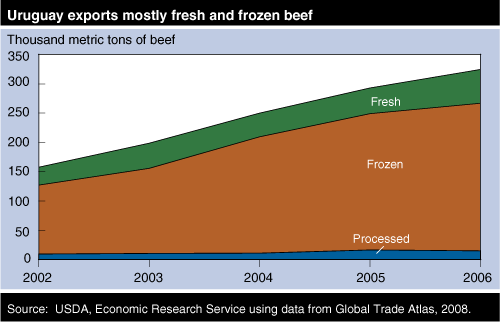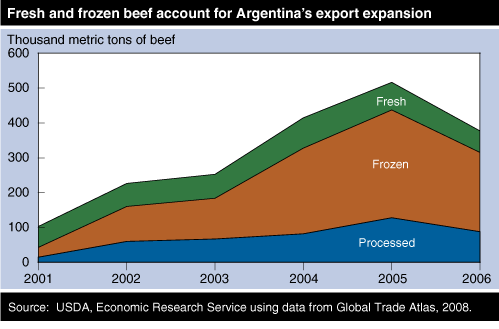Global Market Opportunities Drive Beef Production Decisions in Argentina and Uruguay
- by Michael J. McConnell and Kenneth Mathews
- 4/1/2008
Highlights
- Argentina and Uruguay are increasingly important suppliers of beef in global markets.
- Keys to both countries’ success in international markets are certification and traceability programs, which have been improved in response to recent cattle disease outbreaks.
- Grass-based production systems and bans against feeding meat and bone meal to cattle have helped allay importers’ concerns about bovine spongiform encephalopathy (BSE).
Over the past decade, export markets have had a growing influence on the beef industries in Argentina and Uruguay. Together, the two countries provide 13-20 percent of U.S. beef imports, as well as significant amounts to the European Union (EU). Uruguay exports roughly 80 percent of its production while Argentina is more oriented to meeting the demands of its beef-loving domestic market. Exports account for around 20 percent of its production.
In 2007, Argentina’s cattle herd was estimated at 51.2 million head, compared with Uruguay’s 12.1 million. Both countries have suffered recent outbreaks of foot-and-mouth disease (FMD) and are under pressure from their major trading partners to control disease outbreaks. The U.S. and the EU require beef export certification (processing plants must meet protocols and sanitary standards acceptable to each importer), and each has its own beef import requirements. The need to meet the demands of these markets has motivated Argentine and Uruguayan beef producers to adopt production practices designed to allay international concerns about animal disease and residual growth hormones in beef.
To address such concerns, Argentina and Uruguay have implemented traceability systems that identify the farm-of-origin and indicate whether the animals have been in areas exposed to FMD. Both countries promote their grass-fed beef production as a “healthier” system, which, combined with bans against feeding meat and bone meal to cattle, reduces BSE concerns among importers. Export markets are important to both countries, and their beef industries are increasingly shaped by the demands of foreign buyers.
Both Countries Free of BSE But Wrestle With FMD
In May 2005, the World Animal Health Organization (originally named the Office International des Epizooties and still known by its abbreviation, OIE) revised its guidelines on countries’ exposure to and potential for spreading BSE. Argentina and Uruguay remained in the lowest (“negligible risk”) risk category. They achieved BSE-free status through pasture-based cattle and beef production technologies and bans on using meat and bone meal (MBM), a high-protein material rendered from animals, in animal feed. Argentina and Uruguay, along with many other countries, imposed bans on feeding MBM to cattle and other ruminants in 1996, after the United Kingdom announced a possible link between BSE and variant-Cruetzfeld-Jakob Disease (vCJD) in humans. Infected MBM is thought to be the vector for spreading BSE. In Argentina and Uruguay, the ban against MBM in feed extends to all ruminant livestock feed, including feed for cattle held in feedlots, where the animals are fed rations containing high levels of grains and proteins.
Unlike BSE, foot-and-mouth disease has been an issue for nearly all South American beef producers. OIE has issued guidelines for how a country can achieve and maintain FMD-free status. One country’s success at maintaining that status can be influenced by neighboring countries’ disease-control efforts. In 2001, an outbreak of FMD along the border shared by Argentina, Uruguay, Paraguay, and Brazil resulted in the voluntary suspension of beef exports from all of those countries.
An outbreak in 2000 cost Uruguay its FMD-free status (held since 1995) from the OIE. The regional FMD outbreak in 2001 further damaged Uruguay’s trading status. Since 2001, however, Uruguay has not had any new cases of FMD and is currently classified “FMD-free with vaccination” by the OIE. Uruguay was able to resume its beef exports to the U.S. in 2003. Although USDA does not consider Uruguay to be “FMD-free without vaccination,” Uruguayan beef imports to the United States are allowed under specific guidelines established by the U.S. Government.
Argentina had another outbreak in 2006 and is currently able to export only thermo-processed beef (heated to a specific temperature for a specified amount of time) to the United States. In addition, importing nations’ FMD-based fears have prevented Argentina from making inroads in major Asian markets. In January 2007, USDA proposed recognizing the Patagonia area of southern Argentina as FMD-free without vaccination, but has yet to make a final ruling. Such recognition would permit exports of raw and processed beef products from this region to the United States. Patagonia accounts for about 2 percent of Argentina’s cattle.
Domestic Policies Respond To Global Markets
At the same time that Argentina and Uruguay were coping with FMD outbreaks, external forces affected their economies as well. The impacts of a steep devaluation of the Brazilian currency (Real) in 1999 spilled over the borders, first to Argentina and then to Uruguay, making all three countries’ goods less competitive on the global market. This was enough to push the export-reliant Argentine and Uruguayan economies into recession. The simultaneous internal shock of FMD was even more difficult to address because of the broader economic conditions in the region. Although the two countries faced similar challenges, they chose different paths to recovery.
Because Uruguay’s beef industry was more export dependent, the industry was also sensitive to trade interruptions related to disease outbreaks. Uruguay’s domestic beef consumption declined after the recession, and its beef production and exports dropped significantly in 2001. Exports expanded in 2002, but because of FMD, the U.S. did not accept beef imports from Uruguay again until 2003. Since then, Uruguayan agricultural exports, especially beef, have played a large role in the country’s economic recovery. In 2005, beef accounted for 22 percent of Uruguay’s total export value.
The Uruguayan Government currently intervenes minimally in the country’s beef market. As the disease outbreaks subsided, the government allowed market conditions to drive the recovery of the beef sector. Domestic beef consumption began a gradual rebound in 2006 and is expected to continue increasing. Although well below its peak in the late 1990s, Uruguayan per capita consumption re-mains among the highest in the world. Uruguay’s beef production in 2007 was projected to be more than double its 2001 level, and beef exports more than triple.
With exports accounting for 80 percent of Uruguay’s production in recent years, the country’s beef industry and government are oriented toward the world market. The Uruguayan Government has recently reduced several domestic taxes that affect beef. Uruguay has become an important beef-exporting country, with Chile, Brazil, the United Kingdom, Germany, and the U.S. among its biggest customers for fresh/chilled beef. Uruguay faces tariff-rate quotas in several of those importing countries, including a 20,000-metric-ton (MT) quota in the United States; 11,000 MT in Canada; and 6,300 MT under the Hilton beef quota, which limits the import of high-quality fresh and frozen beef into the EU.
The beef industry was less significant in Argentina’s post-2001 economic recovery. Monetary, fiscal, and exchange-rate policies, in addition to strong commodity exports, were credited for Argentina’s turnaround, which has since seen the economy grow as much as 8 percent per year. However, the strong growth has caused inflationary concerns and prompted price-stabilizing policies. Beef plays a major role in Argentine household budgets, accounting for about 4.5 percent of the Argentine inflation index. Thus, the beef industry is an important factor in domestic policy. Measures such as export taxes, minimum slaughter-weight restrictions, and price controls have been used to ensure the supply of beef meets domestic demand without raising prices. In 2006, the Argentine Government limited beef exports to 70 percent of the prior year’s exports, and, in 2007, it set a monthly export quota of about 40,000 tons carcass-weight equivalent. While helping stabilize price levels at home, these measures have hurt Argentine beef producers’ ability to trade in foreign markets.
Argentine Government policies have had several unintended effects. Producers have shifted from grazing cattle to growing grains and soybeans, commodities for which policies have been less disruptive in international markets. Along with this acreage shift, cattle production is also shifting into the northern areas of Argentina, away from the more fertile, crop-friendly central regions. These areas are more susceptible to new FMD outbreaks because of the northern border. Overall, these policies have caused Argentine beef producers to give up foreign market share, much of which Uruguay, Brazil, and Paraguay have seized. However, beef output in Argentina has remained quite stable during these years.
Traceability Aims To Protect Animals and Improve Productivity
Animal traceability has become a priority in both countries as a result of the outbreaks of FMD and foreign customers’ demands to know the sources of their food. Animal identification systems help locate the source of an outbreak and mitigate against further spread of the disease through the isolation of key at-risk herds. Argentina and Uruguay implemented mandatory national animal identification systems, after having less formal systems in place for several years. The animal identification programs in place in both countries now make it possible to track animals from birth to slaughter.
Before 2007, traceability in Argentina was an informal system. Primarily through word-of-mouth and based on the reputation of suppliers, the beef industry was able to assure the retail and export markets of the quality of beef final products. The system was sufficient to maintain the confidence of the Argentine domestic market, as well as that of many of its foreign customers. But the programs were inadequate to meet the needs of all foreign buyers of cattle and beef. In 2007, Argentina instituted a compulsory identification program, requiring that all calves born after September 2007 carry official tags. The entire herd is expected to be tagged by 2017.
Uruguay has a comprehensive national animal identification program aimed at animal disease control, quality beef production, and marketing. A pilot program of animal identification, administered by the government-created Division de Controlar de Semovientes (DICOSE), was established in 1973. The pilot program was designed to improve animal health and fight against illegal smuggling. All cattle operations in Uruguay were required to have documentation on each animal in their herds. The program required hide branding and documentation each time an animal was bought, sold, or transported. Copies of each transaction went to the buyer, seller, local police stations, and the Ministry of Livestock, Agriculture, and Fisheries. The DICOSE system made Uruguay one of the first countries able to track an animal to its origin and ensure that ranchers and producers were complying with sanitary requirements.
In September 2006, Uruguay moved to a mandatory system of two ear tags, one highly visible and the other containing electronic information. Cattle are tagged before they reach 6 months of age or are moved from their farm of birth. Lost tags are required to be replaced. These tags include information on the individual animal, the farm from which it originated, and its ownership and movement history. While the Uruguayan Government currently pays for tags, plans are for producers to assume that cost in the future. The government plans to have all herds registered and all cattle tagged by 2010.
Beginning in 2010, the Uruguayan Government will require traceability not only of beef cattle from birth to slaughter, but also of all cuts of beef back to their farm of origin. Currently the individual cuts of meat can be traced back to the final pen from which the animal came from, but it is not possible to identify the specific animal or its origins.
The planned second phase of this system would allow carcasses to be tracked beyond slaughter and would allow producers to obtain information on the post-mortem performance of their cattle. In addition to identifying and tracing animals in the event of a disease outbreak or food-safety event, producers could use this information to compare the performance of their cattle with national averages. As designed, the system would maintain producer confidentiality. These programs focus on using technology to better manage the beef sector and allow Uruguay to maintain access to the export markets upon which its beef industry depends.
Production Systems Promote Safe, Healthy Beef Internationally
Uruguayan and Argentine beef cattle are primarily grass-fed in pastures with high-quality grasses, alfalfa, lotus, and clovers. Animals that are finished in “confinement” are generally placed in smaller pastures, and their diets are supplemented with grains and forage, such as corn silage. While North American-style grain feedlots can be found in both countries, they are not common because of the relatively high cost of grain-based feed. Neither Argentina nor Uruguay permits feeding or implanting artificial growth hormones or feeding antibiotics as growth promotants—Uruguay banned growth hormones in 1978; Argentina banned both in 2004.
As a result of these production practices, Argentine and Uruguayan beef have a number of characteristics attractive to customers. Grass-fed cattle generally produce leaner meat, and pasture-based production is typically seen as less harmful to the environment than some other production technologies. The bans against feeding or implanting artificial hormones and feeding sub-therapeutic antibiotics allow Argentine and Uruguayan beef to be imported into the EU, a market generally closed to U.S. beef. Global demand for beef products with these characteristics continues to increase.
Certification is frequently part of export verification processes imposed by importing countries. Standards are often higher for exported beef than for domestic beef, and plants that export beef usually must be certified to ensure that they comply with the importers’ veterinary, animal health, and sanitation standards. Argentine and Uruguayan beef-manufacturing facilities are modern and clean, and those that export meet the conditions established by export verification programs in the United States, the EU, and other importing countries. Sanitary sampling is conducted regularly in plants to ensure the product reaches company standards as well as domestic and international market demands. Uruguay is able to certify that its beef processing plants meet regulations put in place to allow fresh and frozen meat to be exported to the United States, despite its current status as FMD-free with vaccination. Argentina’s thermo-processed beef meets the export verification requirements of USDA’s Food Safety and Inspection Service.
In addition, in 2004, USDA announced that Uruguay’s certification program was “Process Verified,” according to a USDA program that validates marketing claims made by suppliers. In this case, USDA verifies for U.S. consumers that the “natural” label placed on Uruguayan beef is consistent with U.S. criteria. “Natural” means that a credible third party has certified that the source is verified from ranch, to harvest, to fabrication, and packing; no added hormones or growth promotants were administered to the animal; no sub-therapeutic antibiotics were administered to the animal; no animal proteins were given to the animal as feed; the animal was raised and fattened on a grass-fed diet; and the animal was on open range and never confined to a yard or feedlot.
Uruguay’s grass-fed production system is internationally recognized as an independently certified source of natural beef. The “Certified Natural Meat Program of Uruguay” maintains consumer confidence and differentiates Uruguayan meat through certified compliance with international protocols for animal production and industrial practices. Uruguay is also in the process of obtaining certification for organic beef production through EUREPGAP, a private-sector certification body in Europe that institutes standards addressing consumers’ concerns regarding product safety, environmental impacts, and labor conditions throughout the supply chain.
Beef Will Remain an Important Industry for Trade in Uruguay and Argentina
Trade has differing roles in Argentina and Uruguay and has affected policies and programs related to each country’s livestock and beef industries. Argentina’s policies have not been as export- friendly as Uruguay’s, due to beef’s role in Argentina’s domestic economy. Enhanced traceability programs will help both countries manage and mitigate disease outbreaks, as well as meet the health and sanitary standards of international customers.
This article is drawn from:
- Mathews, K. & Vandeveer, M. (2007). Beef Production, Markets, and Trade in Argentina and Uruguay: An Overview. U.S. Department of Agriculture, Economic Research Service. LDPM-15901.





